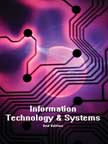Information Technology & Systems
 |
Details
Textbook Edition: II
Pages : 490;
Paperback;
210 X 275 mm approx.
Detail Table of Contents
Workbook Edition: II
Pages : 231; Paperback;
210 X 275 mm approx.
Pricing
Textbook Price: Rs. 900;
Workbook Price: Rs. 700;
Available only in INDIA
Computer Networks : Chapter 9
SUMMARY:
Computer networks can be used for various purposes. For individuals, networks offer access to a variety of information and entertainment resources.
|
|
LANs are privately-owned networks which are used in a single building or an office to connect various workstations and share other resources such as printers, files, etc. MANs are a larger version of LANs and use the same technology that LANs do. Typically, they connect users spread over various parts of a city. A WAN connects a large geographical area, often a country or a continent.
|
Network operating systems are divided based on whether they are peer-to-peer or client/server networks. The important network topologies are mesh, star, bus, ring, tree, and hybrid.
|
The different ways in which data can be transmitted over a network are termed as switching alternatives. The various switching alternatives available are circuit switching, message switching, and packet switching.
Related Books:-
 Case Studies in IT and Systems
Case Studies in IT and Systems
263 pages, Paperback
Available only in INDIA

